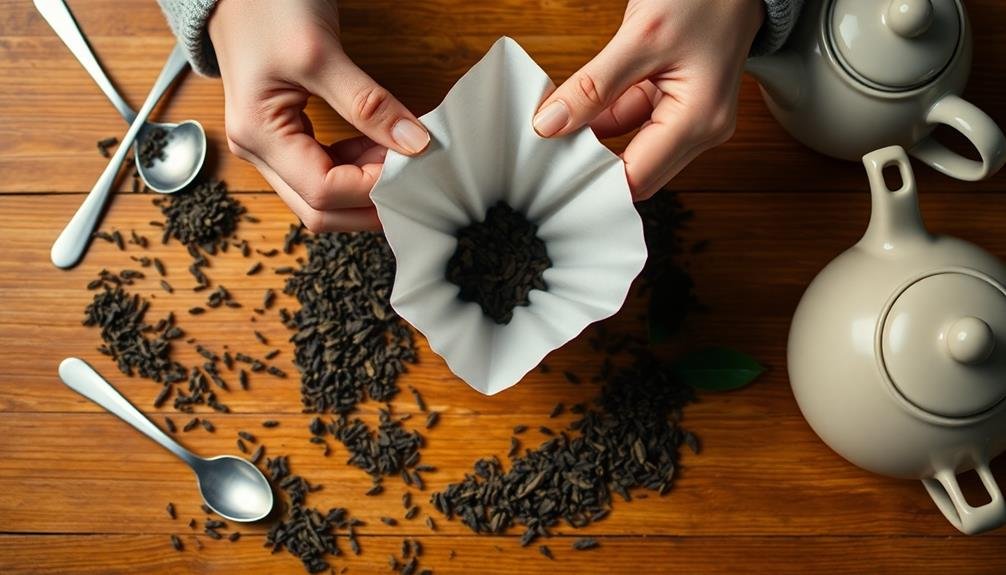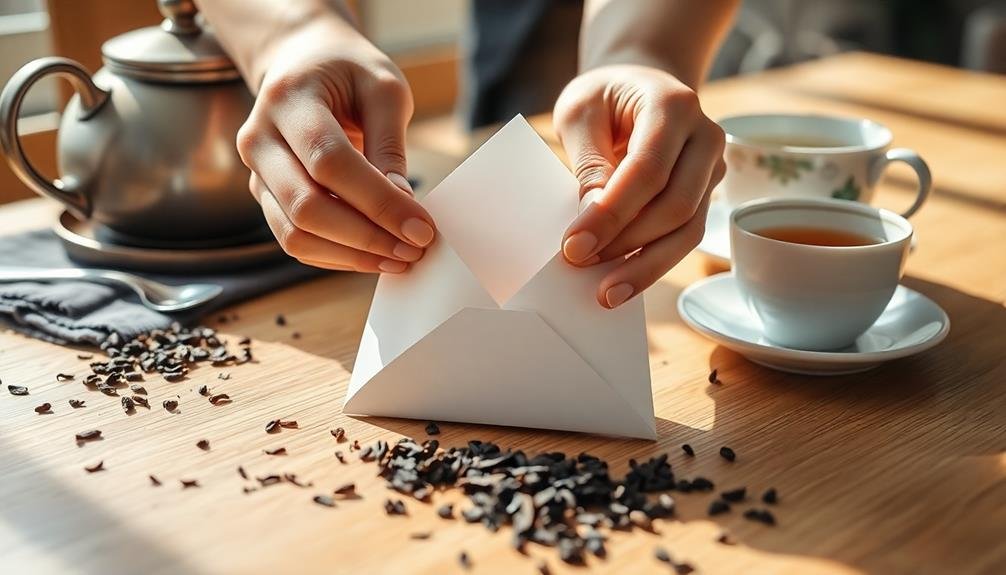You can easily create your own tea bags using three simple folding methods. The Classic Pyramid Fold starts with a square filter paper, creating an X crease before forming a narrow rectangle for filling. The Simple Square Pocket Method uses diagonal folds to create a triangle pocket, which is then sealed. For an artistic touch, try the Origami-Inspired Tea Envelope Technique, which forms a compact square with multiple layers. Each method allows you to customize your tea blends while reducing waste and saving money. These techniques are just the beginning of your journey into homemade tea bag crafting.
The Classic Pyramid Fold

The Classic Pyramid Fold is a tea bag origami staple that's both elegant and functional. To create this fold, you'll need a square piece of filter paper and some loose tea.
Begin by placing the paper flat on your work surface, then fold it diagonally to form a triangle. Unfold and repeat in the other direction, creating an X crease.
Next, fold each corner into the center point, forming a smaller square. Flip the paper over and repeat this step. You'll now have an even smaller square.
Fold two opposite corners into the center, then fold the remaining two corners up to meet them. This creates a narrow rectangle.
To finish, fold the rectangle in half lengthwise, then fold the short ends towards the center, leaving a small gap. This gap allows you to add your loose tea.
Once filled, pinch the edges to seal, and attach a string if desired. Your pyramid tea bag is now ready for steeping.
This method works well for a variety of tea blends and allows for easy customization of portion sizes. It's a practical skill for tea enthusiasts who prefer to craft their own tea bags.
Simple Square Pocket Method
Crafting a simple square pocket tea bag offers a quick and efficient method for brewing your favorite loose leaf teas. To create this style, you'll need a square piece of filter paper or a pre-cut disposable tea filter. Begin by placing the paper flat on your work surface.
Add your desired amount of loose tea to the center of the square. Typically, one to two teaspoons per cup of water is sufficient, but adjust according to your taste preferences.
Carefully fold the paper in half diagonally, creating a triangle shape. Next, fold the two bottom corners up to meet at the top point, forming a smaller triangle.
Now, fold the left and right sides inward, overlapping them slightly in the middle. This creates a pocket that securely holds the tea leaves. To finish, fold the top flap down to seal the pocket. You can secure it with a staple if needed, though many filter papers will hold their shape without one.
This method works well for single-serve portions and allows for easy disposal after brewing. It's also versatile enough to accommodate various tea blends and quantities.
Origami-Inspired Tea Envelope Technique

For tea enthusiasts seeking a more elegant presentation, the origami-inspired tea envelope technique offers a stylish alternative. This method transforms a simple square of paper into a charming envelope that cradles your tea blend.
Begin with a square sheet of thin, food-safe paper. Fold it diagonally, then unfold and repeat in the other direction. Next, fold each corner to the center point, creating a smaller square. Flip the paper over and fold the corners to the center again. Now, you'll have a compact square with multiple layers.
To create the envelope shape, gently lift two opposite corners and fold them towards the center, leaving a small gap. Tuck one corner into the pocket of the other. Fill the resulting pouch with your tea blend, then seal it by folding the remaining two corners inward and tucking them into each other.
This technique not only protects your tea but also adds an artistic touch to your tea-drinking experience. You can customize the envelopes with different papers or add decorative elements for a personal flair.
It's an impressive way to present homemade tea blends as gifts or to elevate your daily tea ritual.
Frequently Asked Questions
How Long Can Homemade Tea Bags Be Stored?
You can store homemade tea bags for up to six months if you keep them in an airtight container in a cool, dark place. However, for the best flavor and freshness, it's recommended to use them within three months.
What Materials Are Best for Making Reusable Tea Bags?
You'll want to use unbleached cotton muslin, organic hemp fabric, or food-grade silicone for reusable tea bags. They're durable, heat-resistant, and won't affect flavor. Avoid synthetic materials that might release chemicals when exposed to hot water.
Can Tea Bag Folding Techniques Be Used for Other Purposes?
You can definitely use tea bag folding techniques for other purposes. They're great for making decorative paper crafts, origami-style ornaments, and gift wrapping embellishments. You'll find these skills useful for creating unique cards and scrapbook designs too.
Are There Eco-Friendly Alternatives to Traditional Tea Bag Materials?
Yes, you can use eco-friendly alternatives for tea bags. Try reusable cloth bags, biodegradable cornstarch mesh, or unbleached paper filters. You'll reduce waste and enjoy a more sustainable tea experience while still savoring your favorite blends.
How Do You Properly Seal Homemade Tea Bags Without Special Equipment?
You can seal homemade tea bags without special equipment by using a simple fold-and-staple method. Fold the top edge of the bag over twice, then secure it with a staple. Alternatively, you can tie it closed with string.
In Summary
You've now mastered three simple yet effective tea bag folding techniques. Whether you prefer the classic pyramid, the square pocket, or the origami-inspired envelope, you'll be able to package your homemade tea blends with ease and style. Don't be afraid to experiment with different papers and sizes to suit your needs. With these methods in your repertoire, you're well-equipped to create beautiful, functional tea bags that'll impress your friends and elevate your tea-drinking experience.





Leave a Reply